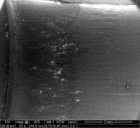I have a 6 mm Remington AI that I have been keeping track of the rate of erosion on, and find it interesting that bullets with different ogives show considerably different changes in jam length over time.
As an example, the jam length for 105 Berger hybrids has lengthened 0.027" from new, while the jam length for 95 grain Nosler BTs has lengthened 0.070 over that same time.
I believe it has to do with the shape of the bullet and how it engages the lead, but I would never have guessed that the difference would be so great from one bullet shape to the next. 70 thou erosion in 5-600 rounds is terrible, while 25 thou would be considered not bad- same barrel same amount of erosion, just tracked with different bullets.
Anyone have similar experience?
Thanks
As an example, the jam length for 105 Berger hybrids has lengthened 0.027" from new, while the jam length for 95 grain Nosler BTs has lengthened 0.070 over that same time.
I believe it has to do with the shape of the bullet and how it engages the lead, but I would never have guessed that the difference would be so great from one bullet shape to the next. 70 thou erosion in 5-600 rounds is terrible, while 25 thou would be considered not bad- same barrel same amount of erosion, just tracked with different bullets.
Anyone have similar experience?
Thanks











